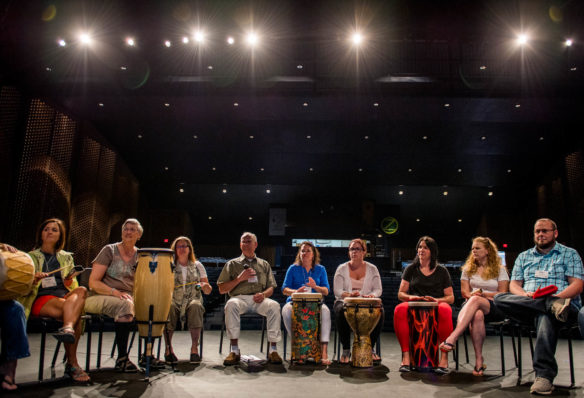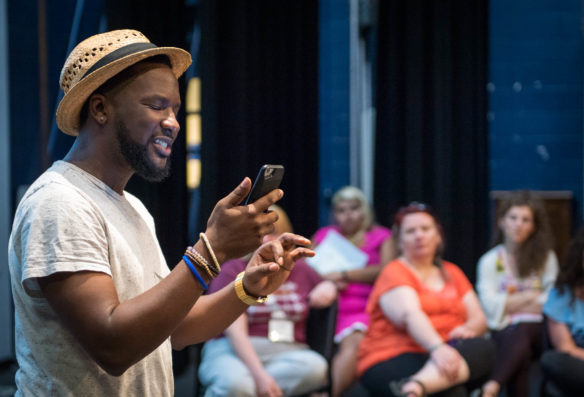
Teachers participated in a drum circle each morning during the Arts-Literacy Integration Academy as a way to build community. This was the 17th year for the academies sponsored by the Kentucky Center for the Performing Arts and the Kentucky Department of Education.
Photo by Bobby Ellis, June 20, 2017
By Brenna R. Kelly
Brenna.kelly@education.ky.gov
The hip hop beat of the song “My Shot” from the Broadway musical “Hamilton” was transformed with the twang of a Bluegrass tune and teachers strumming a guitars. The witches chant from Shakespeare’s Macbeth took on the beat of a bongo drum while teachers called out in unison: “Double, double, toil and trouble; Fire burn, and cauldron bubble.”
These exercises were just two of the many ways 24 teachers explored the connections between music and literacy during the weeklong Arts Integration Academy in Danville. The academy was one of five arts academies held this summer by the Kentucky Center for the Performing Arts and the Kentucky Department of Education (KDE). The other academies focused on school-based leadership, assessing student work with artistic criteria and integrating arts and world languages.
“We really wanted something this year for the high school music teachers and high school English teachers to connect,” said Jeffery Jamner, Kentucky Center senior director of education and community arts. “We’re looking at the musicality of language and the linguistic characteristics of music and how both of them are languages of emotion and human experience.”
Using the connections between music and literature could inspire reluctant readers or help students develop a deeper understanding of a piece of music they are singing, Jamner said.
“There’s an emphasis on literacy everywhere,” Jamner said. “Band directors and choir directors are being asked to make literacy connections, so we wanted to help them make strong connections.”
Teaching students to see how music and literature share rhythm and form can help them understand both in a deeper way, he said. For example, setting the witches chant to a drumbeat helps students understand the emphasis Shakespeare places on syllables.
KDE Arts Consultant Kyle Lee, who participated in the academy, said all teachers can benefit from stepping outside their content areas.
“Whenever educators are able to make cross-curricular content connections, the relevance of learning is always elevated,” Lee said. “As teachers in the 21st century, we must stop thinking in silos such as, ‘I’m the science teacher, I’m the math teacher, I’m the music teacher.’ We need to start thinking about who we teach, not what we teach.”
Amanda Wright, 9th-grade English teacher at Lafayette High School (Fayette County), said she was particularly inspired during the academy when violinist Sara Soltau played along with the book “Ferdinand the Bull.”
“We didn’t just experience the words and the pictures, we heard it too, and we felt it,” Wright said. “If we can get our students to engage on multiple levels – if they can hear it, feel it, create it, paint it, whatever – then it becomes theirs. They own it.”
Wright said she plans to begin using music in her classes this school year.
“Maybe instead of asking how would you characterize this character, asking them what song would be this character’s theme song,” she said. “Things like that will engage students on a different level.”

The Louisville poet, Brandon “B.Shatter” Harrison, performs one of his spoken word poems for a group of teachers at during the Arts-Literacy Integration Academy. Spoken word poems helped teachers see the connection of music and literature through rhythm.
Photo by Bobby Ellis, June 20, 2017
Teachers at the academy also explored the rhythm of poems with Louisville spoken-word artist Brandon Harrison, who goes by the name B.Shatter. Jamner pointed out how poets use the same tools as musicians, including pacing, accent and repetition.
To show how easily poems can become music, Soltau picked up her violin and accompanied B.Shatter as he performed a poem while Lee added a beat with a large hand drum.
Soltau played a piece from Bach that followed an AABB form, then Jamner explained how Shakespeare’s sonnets have couplets that are an AABB form.
The teachers also explored the similarities between “Hamilton” and “Macbeth.”
“The spoken word is kind of a way into the rhythm of the language, both in Shakespeare and in Hamilton,” Jamner said. “They actually have a lot in common.”
For example, Shakespeare uses different language for different classes of people, while “Hamilton” uses different types of music for different groups, such as the colonists, the Founding Fathers and King George. To explore the language in the Hamilton song, “My Shot,” teachers reworked the song into another genre of music. The result was Bluegrass, gospel, and country and western versions of the rap song.
At the end of each day, the teachers discussed what they learned and how they would implement it in their classrooms. Some of the teachers came as a team of music and English teachers, but for those who came alone, Jamner urged the music teachers to seek out the English/language arts (ELA) teachers in their building and the ELA teachers to seek out the music teachers.
Each should use the other as a resource to help make strong music and literacy connections that will lead to deeper learning, he said.
“Don’t try to force weak connections or even have a weak connection,” Jamner said. “If the connections are strong and meaningful, you can do so much with them.”
Music teacher Mark Dycus said he’s known for a while that he should be making literacy connections to the pieces his choir students perform.
“It’s just too easy to fall back on the default,” said Dycus, who has been teaching choir at Calloway County High School for 22 years. “Just being here has sparked some ideas that I will take and wrestle with, and I am confident they will evolve into classroom procedures that will help us dissect the text, analyze the text apart from the musical context. That will allow us to understand the piece on its own terms first and then we will work to blend that with the music.”
Emily Warne, who teaches English and drama at Johnson Central High School (Johnson County), said she plans to use music to help her reach students who aren’t interested in reading.
“This will give me a chance to create an English classroom that even my non-English-loving students can enjoy,” she said. “I enjoy opening the eyes of those who don’t want to be there. I prefer the collaborative classes and the kids who unexpectedly find they love learning. And this will give me the tools to do that.”
MORE INFO …
Jeffery Jamner jjamner@kentuckycenter.org
Kyle Lee Kyle.Lee@education.ky.gov



Leave A Comment